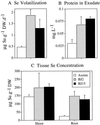Rhizosphere bacteria enhance selenium accumulation and volatilization by indian mustard
- PMID: 9952452
- PMCID: PMC32133
- DOI: 10.1104/pp.119.2.565
Rhizosphere bacteria enhance selenium accumulation and volatilization by indian mustard
Abstract
Indian mustard (Brassica juncea L.) accumulates high tissue Se concentrations and volatilizes Se in relatively nontoxic forms, such as dimethylselenide. This study showed that the presence of bacteria in the rhizosphere of Indian mustard was necessary to achieve the best rates of plant Se accumulation and volatilization of selenate. Experiments with the antibiotic ampicillin showed that bacteria facilitated 35% of plant Se volatilization and 70% of plant tissue accumulation. These results were confirmed by inoculating axenic plants with rhizosphere bacteria. Compared with axenic controls, plants inoculated with rhizosphere bacteria had 5-fold higher Se concentrations in roots (the site of volatilization) and 4-fold higher rates of Se volatilization. Plants with bacteria contained a heat-labile compound in their root exudate; when this compound was added to the rhizosphere of axenic plants, Se accumulation in plant tissues increased. Plants with bacteria had an increased root surface area compared with axenic plants; the increased area was unlikely to have caused their increased tissue Se accumulation because they did not accumulate more Se when supplied with selenite or selenomethionine. Rhizosphere bacteria also possibly increased plant Se volatilization because they enabled plants to overcome a rate-limiting step in the Se volatilization pathway, i.e. Se accumulation in plant tissues.
Figures







Similar articles
-
Rate-limiting steps in selenium assimilation and volatilization by indian mustard.Plant Physiol. 1998 Aug;117(4):1487-94. doi: 10.1104/pp.117.4.1487. Plant Physiol. 1998. PMID: 9701603 Free PMC article.
-
Overexpression of cystathionine-gamma-synthase enhances selenium volatilization in Brassica juncea.Planta. 2003 Nov;218(1):71-8. doi: 10.1007/s00425-003-1070-z. Epub 2003 Jul 9. Planta. 2003. PMID: 14618405
-
Selenium assimilation and volatilization from dimethylselenoniopropionate by Indian mustard.Plant Physiol. 2000 Apr;122(4):1281-8. doi: 10.1104/pp.122.4.1281. Plant Physiol. 2000. PMID: 10759525 Free PMC article.
-
Review of 15 years of research on ecotoxicology and remediation of land contaminated by agricultural drainage sediment rich in selenium.Ecotoxicol Environ Saf. 2004 Mar;57(3):257-69. doi: 10.1016/S0147-6513(03)00064-2. Ecotoxicol Environ Saf. 2004. PMID: 15041249 Review.
-
Selenium-enriched plant foods: Selenium accumulation, speciation, and health functionality.Front Nutr. 2023 Feb 6;9:962312. doi: 10.3389/fnut.2022.962312. eCollection 2022. Front Nutr. 2023. PMID: 36815133 Free PMC article. Review.
Cited by
-
Selenium volatilization in plants, microalgae, and microorganisms.Heliyon. 2024 Feb 11;10(4):e26023. doi: 10.1016/j.heliyon.2024.e26023. eCollection 2024 Feb 29. Heliyon. 2024. PMID: 38390045 Free PMC article. Review.
-
An essential role of s-adenosyl-L-methionine:L-methionine s-methyltransferase in selenium volatilization by plants. Methylation of selenomethionine to selenium-methyl-L-selenium- methionine, the precursor of volatile selenium.Plant Physiol. 2002 Oct;130(2):847-56. doi: 10.1104/pp.001693. Plant Physiol. 2002. PMID: 12376649 Free PMC article.
-
Strategies for the engineered phytoremediation of toxic element pollution: mercury and arsenic.J Ind Microbiol Biotechnol. 2005 Dec;32(11-12):502-13. doi: 10.1007/s10295-005-0255-9. Epub 2005 Jul 2. J Ind Microbiol Biotechnol. 2005. PMID: 15995854 Review.
-
Rhizoremediation of metals: harnessing microbial communities.Indian J Microbiol. 2008 Mar;48(1):80-8. doi: 10.1007/s12088-008-0008-3. Epub 2008 May 1. Indian J Microbiol. 2008. PMID: 23100702 Free PMC article.
-
Characterizing bacterial communities in Phragmites australis rhizosphere and non-rhizosphere sediments under pressure of antibiotics in a shallow lake.Front Microbiol. 2022 Dec 6;13:1092854. doi: 10.3389/fmicb.2022.1092854. eCollection 2022. Front Microbiol. 2022. PMID: 36560949 Free PMC article.
References
-
- Abrams MM, Shennan C, Zasoski RJ, Burau RG. Selenomethionine uptake by wheat seedlings. Agron J. 1990;82:1127–1130.
-
- Anderson TA, Guthrie EA, Walton BT. Bioremediation in the rhizosphere: plant roots and associated microbes clean contaminated soil. Environ Sci Technol. 1993;27:2630–2636.
-
- Arvy MP. Selenate and selenite uptake and translocation in bean plants (Phaseolus vulgaris) J Exp Bot. 1993;44:1083–1087.
-
- Atkinson R, Aschmann SM, Hasegawa D, Thompson-Eagle ET, Frankenberger WT., Jr Kinetics of the atmospherically important reactions of dimethyl selenide. Environ Sci Technol. 1990;24:1326–1332.
-
- Aubert H, Pinta M (1977) Trace Elements in Soils. Elsevier Science Publishers, New York, pp 5–11
LinkOut - more resources
Full Text Sources
Other Literature Sources

